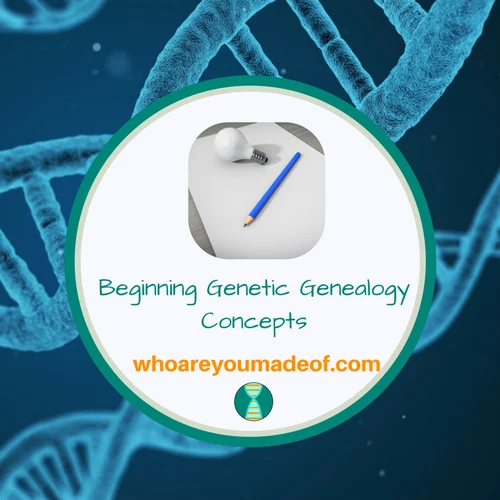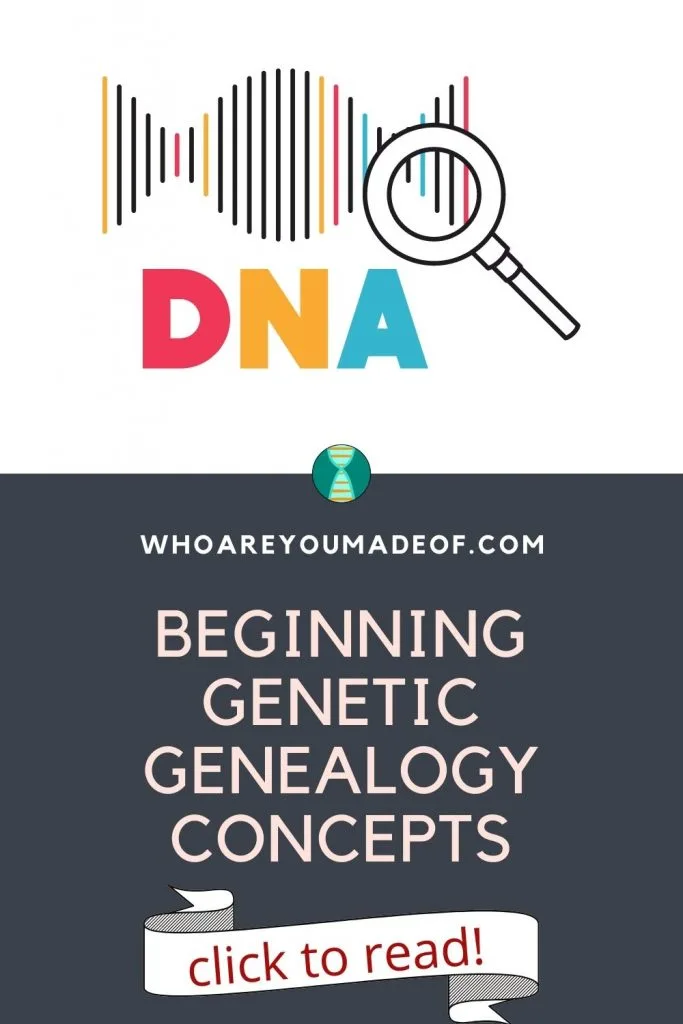If you are brand-new to genetic genealogy, this post is for you. I'll explain the basics of genetic genealogy so you can easily learn how to use your DNA results to build your family tree and discover genetic relatives.
You will learn:
- Exactly what autosomal DNA is
- The meaning of a centimorgan
- The definition of a DNA segment
- How to decipher commonly used acronyms, such as MRCA and NPE
It's so easy to feel overwhelmed by new terminology and complicated scientific concepts. However, it doesn't have to be this way!

My goal here is to break things down in a way that is easy to understand so that everyone who is interested in genetic genealogy can leverage their unique DNA to learn about their roots.
Let's get started, shall we?
What is genetic genealogy?
Genetic genealogy is the use of DNA results and DNA analysis techniques to build a family tree, verify existing genealogy research, and determine the precise genealogical relationship to DNA matches. While most genetic genealogy uses autosomal DNA test results, such as those provided by 23andMe and AncestryDNA, Y-DNA and mtDNA test results can also be used.
There is some debate about whether genetic genealogy is separate from, or an offshoot of, traditional genealogy research. I prefer to view genetic genealogy as a tool in the genealogist's toolbox.
DNA results studied through the genetic genealogist's lens can't replace traditional genealogy research. Furthermore, genealogy is enhanced by the use of DNA studies.
What is a chromosome?
Inside the nucleus of each of your cells are tiny structures that are sometimes described as "threads", made up of DNA that is wound up tightly. These are your chromosomes.
They are so small that they can't even be described as microscopic, since they are not visible under a microscope unless a cell is dividing.
Every human - including you - has 23 pairs of chromosomes. 22 of your chromosomes are what are referred to as "numbered chromosomes", the remaining chromosome is the chromosome which determines whether you are male or female.
Contained within each of your 22 pairs of numbered chromosomes is your DNA. Your unique DNA is what makes you who you are, and it is what DNA testing companies use to compare you with other DNA test takers, and to determine your ethnicity estimate.
Each chromosome is a different size, and thus contains a different number of genes. This is the reason why, if you have ever seen a chromosome browser, the chromosomes shown seem bigger or small than the others.
What is autosomal DNA?
The DNA that is contained within your numbered chromosomes is called autosomal DNA. When autosomal DNA was first discovered by scientists, they did not believe that it had much use.
In fact, scientists used to think that autosomal DNA was "junk DNA". Until the past few decades, they didn't understand the wealth of information that it contains. I'm so glad that they figured out how useful it can be!
Autosomal DNA is different than Y DNA or mtDNA, which is DNA that is inherited in the sex chromosome. The older types of DNA tests could only test our sex chromosomes, but autosomal DNA tests generally only test autosomal DNA. Autosomal DNA is inherited from both of our parents, no matter our gender.
What are centimorgans?
Centimorgans are a unit of measurement used to describe genetic distance. Centimorgans are not a physical distance - you won't find a ruler that measures centimorgans.
The way centimorgans are measured is an advanced topic for beginners, so I'll make sure just to stick with relevant definitions for this post.
When genes are close together on a chromosome, they will likely be recombined, or inherited, together with nearby genes. DNA testing companies have special equipment and technology that can determine the likelihood that a group of genes were inherited together with nearby genes, and how "long" this group of genes is, including start and end positions of the group genes on an individual chromosome.
Geneticists describe this genetic distance in "centimorgans", which is often abbreviated as "cM" or "cMs".
What is a DNA segment?
One way to describe a length of DNA (imagine that you are able to stretch out those wound-up threads and cut off a section) is a DNA segment. In this genetic genealogy world, we describe DNA segments as having length, and use centimorgans to describe the length of the segment.
For example, we might say that I have a 15 cM DNA segment that matches a distant cousin. The length of the DNA segment is 15 centimorgans, and there is a possibility that my cousin and I inherited this identical DNA segment from the same common ancestor.
DNA segments are generally discussed in relation to their size and how the segments match other people, specifically DNA matches. We can share anywhere from a single DNA segment with a match to dozens of segments.
Usually, we share fewer, shorter segments with distant relatives and more, longer segments with close relatives. For example, I'll have many matching DNA segments with my sister, but only one with a very distant cousin.
As a general rule, we expect longer and more numerous shared DNA segments to indicate a closer relationship. Remember how genes that are very close together are more likely to be passed down together?
They would be inherited as a DNA segment. Throughout the generations, DNA segments get smaller, which is why you will only share a small segment with a distant cousin, but larger segments with closer relatives.
What is a DNA match?
When you have a DNA segment, made up of autosomal DNA contained within your chromosomes, that matches a DNA segment of another test taker within the same company's database, the software will report the two of you as a DNA match. These relatives are also called genetic relatives, or DNA relatives, depending on the terminology used by your testing company.
There are a few things to know about who will show up as as DNA match.
Minimum thresholds for counting a segment as a match vary
Each DNA testing company has a "threshold", or a minimum DNA segment length (in cMs), required to be counted as a match. Most companies don't count segments smaller than 4-6 cMs, since the smaller the segment, the higher the probability that the segment is only identical because of coincidence, and not because it was inherited from a common ancestor.
My own term for these small segments are "coincidentally identical DNA segments", but the correct way to describe them is using the phrase "identical-by-state" segments. In other words, they just "happen" to be identical.
Very small DNA segments are likely to be false matches
Many people will share many very small segments with each other (like smaller than 3 cMs). It is unlikely that these shared segments are a result of a genealogical relationship - longer is better!
A good rule of thumb is two people who share segments larger than 7 cMs possibly have an ancestor in common that could be identified if both people had extensive trees going back many generations on all lines.
Shared DNA segments larger than 10 cMs have a better chance of being legitimate shared segments from an identifiable ancestor. The longer the segment (and more numerous the segments) the better the chance that you will be able to identify the common ancestor.
We don't share DNA with all of our relatives
Many people are surprised to learn that we don't share DNA with all of our relatives, especially our more distant ones. We always share DNA with close relatives, and might share DNA with distant cousins. This is why our genealogical family tree won't match our genetic family tree.
What does MRCA stand for?
When you are thinking about identifying the ancestor that you share in common with someone, you want to know the "most recent common ancestor". This term is often abbreviated as MRCA to save time.
You will share many ancestors with your DNA match, but you are only interested in the most recent common ancestor in order to determine your genealogical relationship to each other.
For example, two siblings will share all of their ancestors (thousands upon thousands!), but their MRCA is their parents. Second cousins share their great-grandparents as MRCAs, and third cousins share their great-great grandparents as MRCAs.
You might have a married couple as MRCAs, or just one person, who is your MRCA.
What does NPE stand for?
NPE is an acronym that stands for non-paternity event. Some people incorrectly describe the meaning as "not parent expected", or similar, though the end meaning is the same.
DNA tests often expose family secrets or new information about us or our relatives. In genetic genealogy, a non-paternity event (NPE) is when the person who was believed to be the biological father of a person is proven to not be the father through DNA testing.
Conclusion
I hope that this post has helped give you the basic understanding of some of the most common terms you will encounter while doing genetic genealogy research. If you have any questions about something that you have read here, or would like to add your own experience about learning genetic genealogy, I would love to hear from you in the comments.
Thanks for stopping by!


